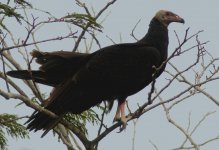Valéry Schollaert
Respect animals, don't eat or wear their body or s
Hi guys,
I've this old photo (Janary 2009) that I identified only thanks to the parents around. Well, a lost bird is not impossible and, more important, I'm looking for features to identify juvenile vultures in case I see one alone. I found litterature poor on the subject. All 3 Turkey, Lesser Yellow-headed and Greater Yellow-headed occur around the area, near Manaus.
Can you be kind enough to tell me how would you identify that individual and, as important, based on what features ?
THANKSSSS
I've this old photo (Janary 2009) that I identified only thanks to the parents around. Well, a lost bird is not impossible and, more important, I'm looking for features to identify juvenile vultures in case I see one alone. I found litterature poor on the subject. All 3 Turkey, Lesser Yellow-headed and Greater Yellow-headed occur around the area, near Manaus.
Can you be kind enough to tell me how would you identify that individual and, as important, based on what features ?
THANKSSSS





